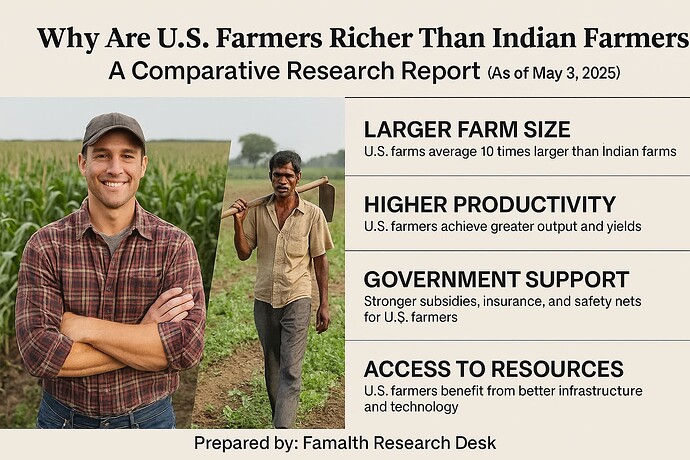Introduction Farming is a vital part of both the United States and India, but the economic well-being of farmers in these two countries shows a sharp contrast. While the majority of Indian farmers struggle with poverty, high input costs, and low returns, American farmers tend to be relatively prosperous, well-mechanized, and often supported by strong institutional structures. This disparity is not just a matter of geography, but a result of systemic differences in policy, infrastructure, technology, market access, and landholding patterns. This report explores the key reasons why U.S. farmers are richer than their Indian counterparts, drawing comparisons across economics, subsidies, market systems, and government interventions.
1. Landholding Size and Mechanization
- USA: The average farm size in the U.S. is around 440 acres (178 hectares), enabling high-scale mechanization and efficiency.
- India: The average landholding is under 1.08 hectares. Fragmented and small farms make mechanized farming uneconomical and labor-intensive.
2. Access to Finance and Credit
- USA: Farmers have easy access to low-interest loans from farm credit institutions and are backed by crop insurance, grants, and subsidies.
- India: Many farmers still rely on informal credit or high-interest loans due to limited bank access and low institutional penetration in rural areas.
3. Government Support and Subsidies
- USA: The U.S. government spends billions annually on farm subsidies, crop insurance, disaster aid, and income support programs.
- India: While MSP and subsidies exist, they are not evenly distributed and often do not reach small farmers. Subsidies are mostly for fertilizers and electricity.
4. Market Access and Supply Chains
- USA: Farmers have access to national and international markets with strong transport, cold storage, and direct buyer linkages.
- India: Most farmers are dependent on middlemen or local mandis with poor price discovery and few opportunities to export.
5. Technology and Innovation
- USA: Widespread use of GPS-guided tractors, drones, AI-based decision-making, precision farming, and genetically modified crops.
- India: Low adoption of modern technologies, limited access to agri-startups, and less investment in R&D and extension services.
6. Education and Training
- USA: High literacy among farmers, with dedicated agricultural universities, extension programs, and online training modules.
- India: Many farmers are illiterate or semi-literate with limited awareness of best practices or market trends.
7. Insurance and Risk Management
- USA: Farmers are protected from crop loss, price volatility, and weather shocks through extensive crop insurance and federal aid.
- India: Insurance coverage under PMFBY exists but suffers from low penetration, slow compensation, and weak grievance redressal.
8. Diversification and Agri-Business Integration
- USA: Farmers diversify with livestock, agro-tourism, ethanol, and contract farming with retail giants like Walmart.
- India: Farming is still highly crop-focused. Integration with food processing or value-added businesses is limited.
9. Policy Stability and Political Clout
- USA: Farmers form a powerful political lobby with a stable policy environment.
- India: Agricultural policy is often reactive and politicized. Farmer unions have voice, but the system lacks long-term planning.
Conclusion The disparity between U.S. and Indian farmers is a result of systemic differences rather than individual effort. While Indian farmers work just as hard, their constraints in land, access to credit, technology, and markets keep them in a vulnerable economic state. India must focus on scaling up institutional support, enabling direct market access, investing in rural infrastructure, and fostering innovation to uplift farmer incomes sustainably.
Prepared by: Famalth Research Desk (May 3, 2025)
